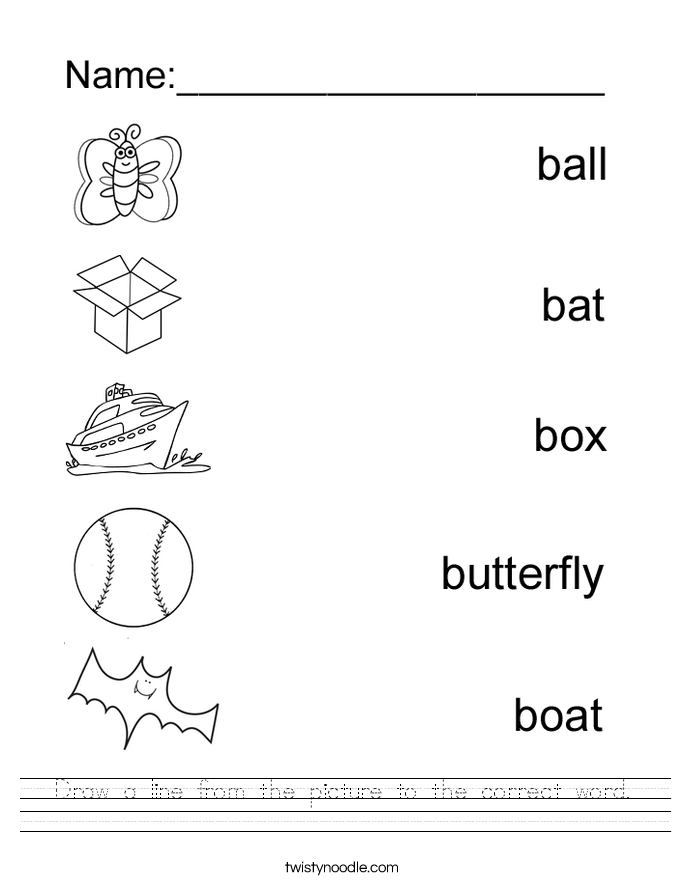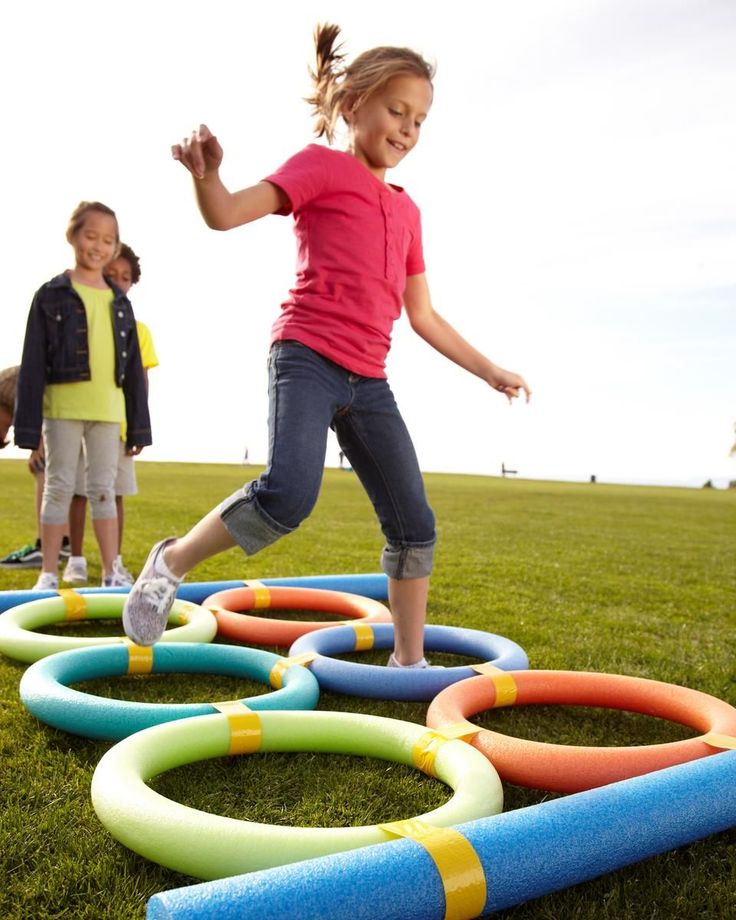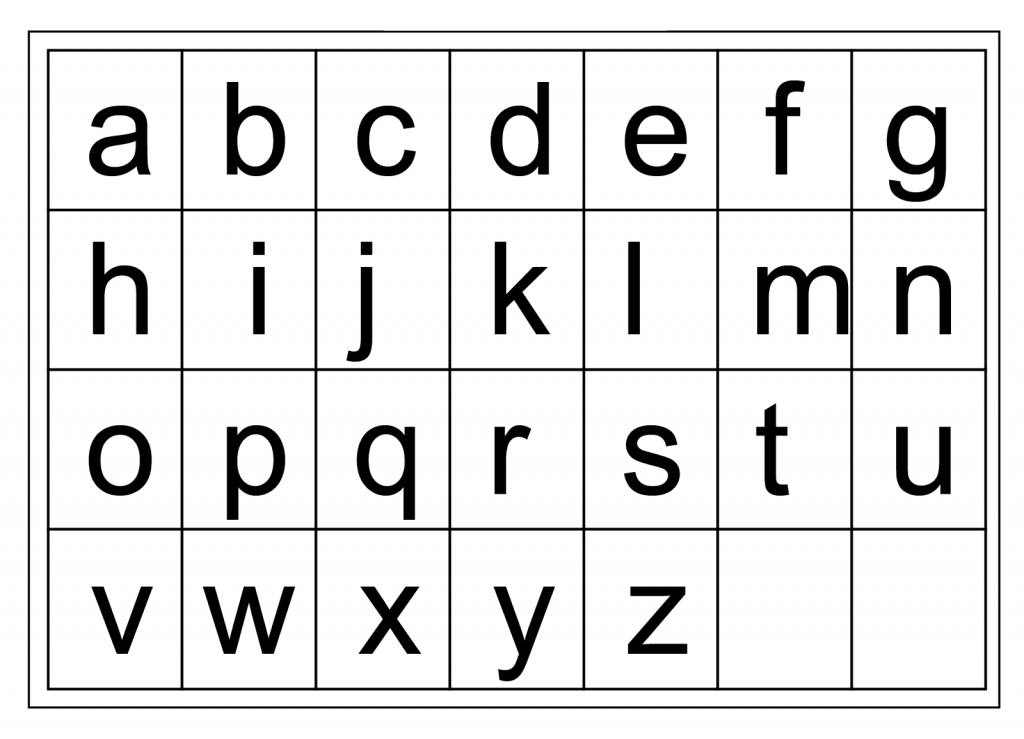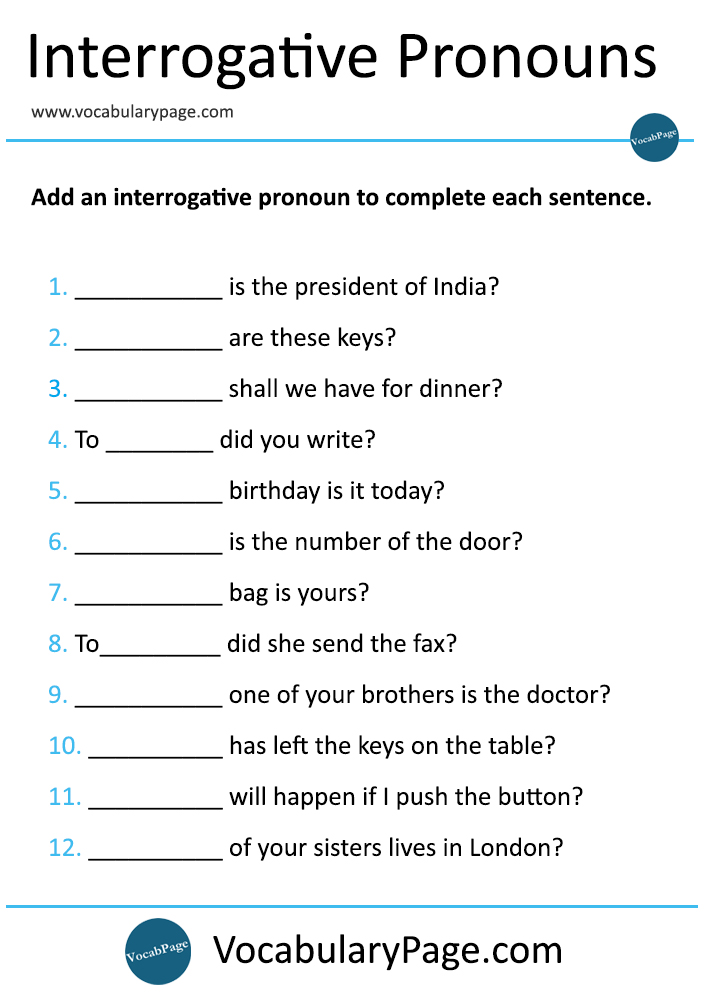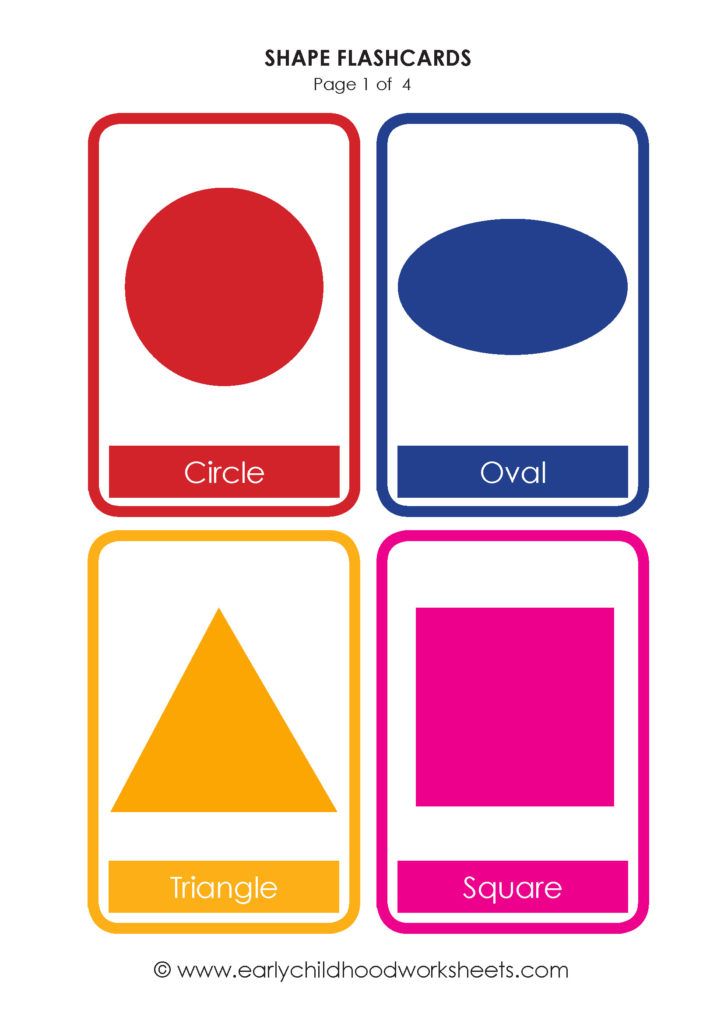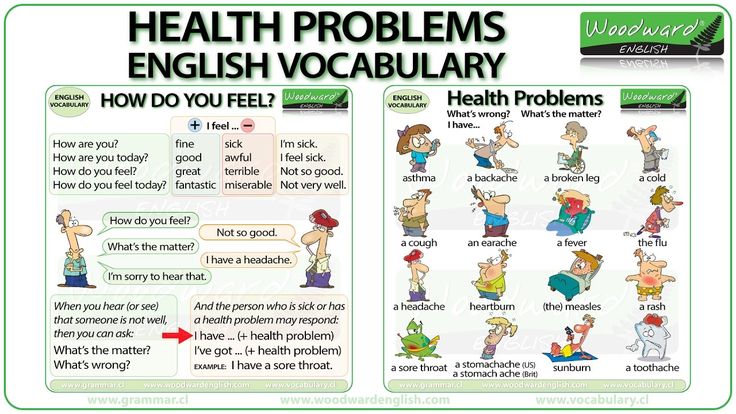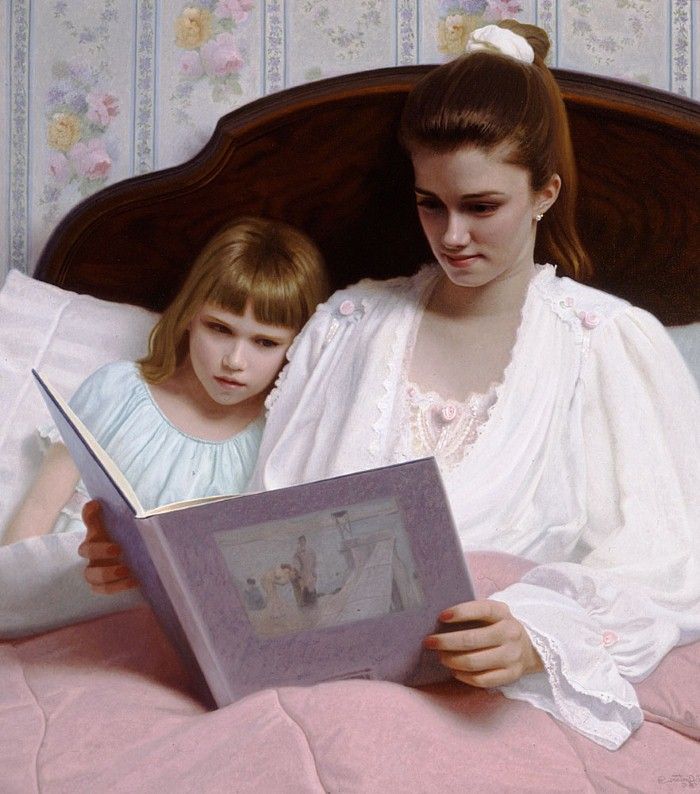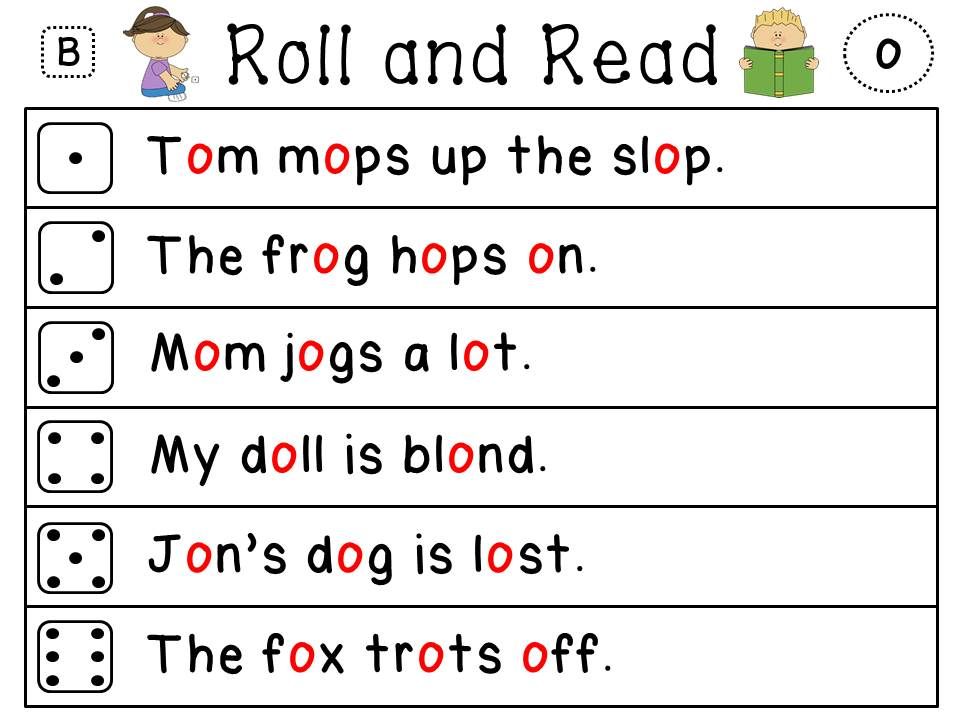Feeling activities for preschool
8 Fun Feelings Activities for Preschoolers
- Share
Early childhood is as much about developing a child emotionally as it is about building physical and intellectual capabilities.
These feelings activities for preschoolers bring art, songs, discussion and stories together, to help kids experience their emotions in practical ways.
How do you teach preschoolers about feelings?
As children progress through the stages of emotional development, they naturally learn to identify their feelings and express them in healthy ways.
Much of a child’s emotional development happens during play.
While children are playing dress-up or engaging in pretend play, they are imitating and acting out real-life scenarios, which are full of emotions.
Pretend play gives children a way to safely act out and practise big emotions such as fear, love, sorrow and anger.
However, parents and teachers can also find opportunities for teaching emotions to preschoolers by planning special feelings/emotions activities.
Here are a few ideas.
1. Mirror Emotions
Give children a hand-held mirror or stand in front of a large mirror. Ask them to explore their emotions in their reflections.
Ask them to make different faces. Start with easier emotions to identify, such as sad, happy and angry. Ask how their faces change as their emotions change.
Then, try to play with emotions such as boredom, excitement and worry. What do those faces look like?
Tell children to think of a cute puppy, running away from a lion, a very sad baby, or a big gift they are about to unwrap. How and why do their faces change?
2. Dance Your Feelings
Challenge kids to make up dances to show what various emotions feel like:
- A tired dance – Use scarves, slow movements and sleepy faces to slow music.
- An angry dance – Stomp around the room, making jerking movements with stern expressions to choppy music.
- An excited dance – Jump around with lit-up faces and a happy tune.
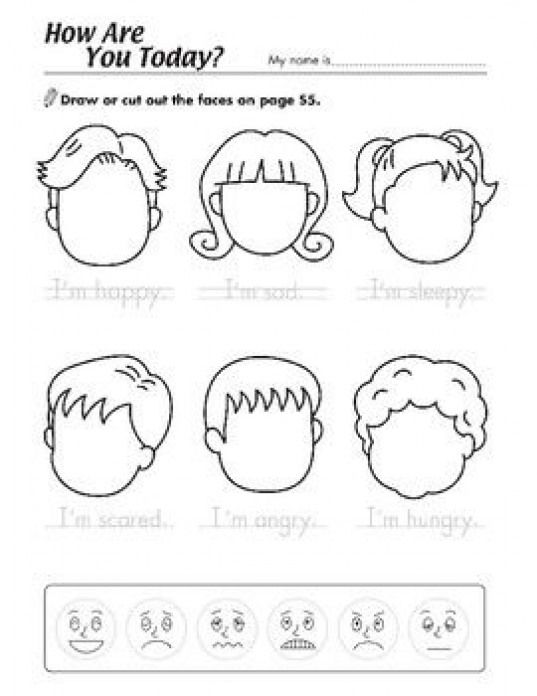
Choose music to match the mood and try out different emotions.
As a variation, play different kinds of music and ask children to show you, through their dancing, how the music makes them feel.
3. Emotion Drawing
Ask kids to draw a picture that explains how they feel.
Do not direct this activity too much. Rather allow children to express themselves with their own creativity. Different children will find different ways of representing their emotions.
Another way to do this is to play music (use the music from the dancing activity above) and ask your children to draw how the music makes them feel.
Tip: use clues from movies to help you choose the sounds, such as a choppy violin that’s used when a shark is approaching, or a slow, classical song that creates a sad atmosphere.
4. How Would You Feel?
Have a discussion about feelings and ask kids how they would feel in various situations.
Here are some examples of questions about feelings:
- How would you feel if…?
- How did you feel when…?
- How does it make you feel when…?
- Tell me about a time when you felt really scared.
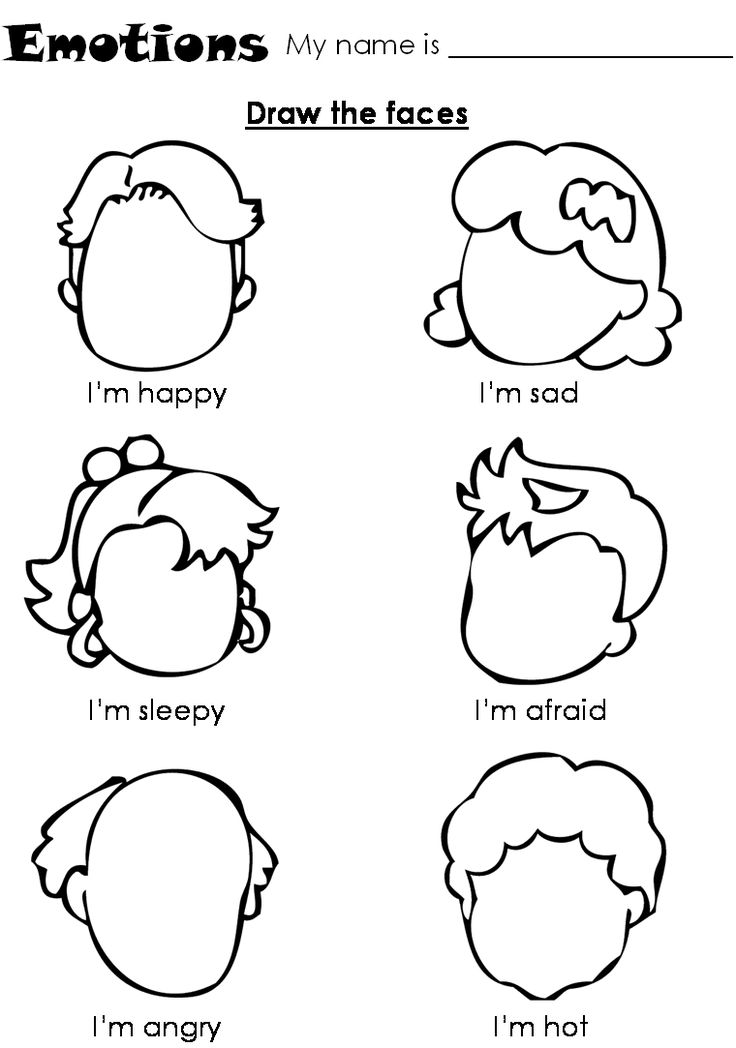
- What does mom do that makes you feel loved?
Learning to verbalize and express feelings is an important part of healthy development.
5. Paper Plate Faces
Creative art is a great way to make a physical representation of emotions.
One of the simplest emotions crafts for preschoolers is to make paper plate faces, depicting various emotions.
These can be turned into masks or you could attach a craft stick (or ice-cream stick) to the bottom and turn them into puppets for kids to use during their dramatic play.
6. Story Time
Story time is one of the easiest ways to incorporate teaching emotions. Books are filled with characters experiencing the full array of emotions and learning important life lessons.
As you read your stories in class or at bedtime, remember to ask questions about what the characters are feeling, why they are feeling that way, as well as how you would feel in the same situation.
7. Feeling Faces
Challenge kids to page through a magazine, or a storybook and identify faces that show strong emotions.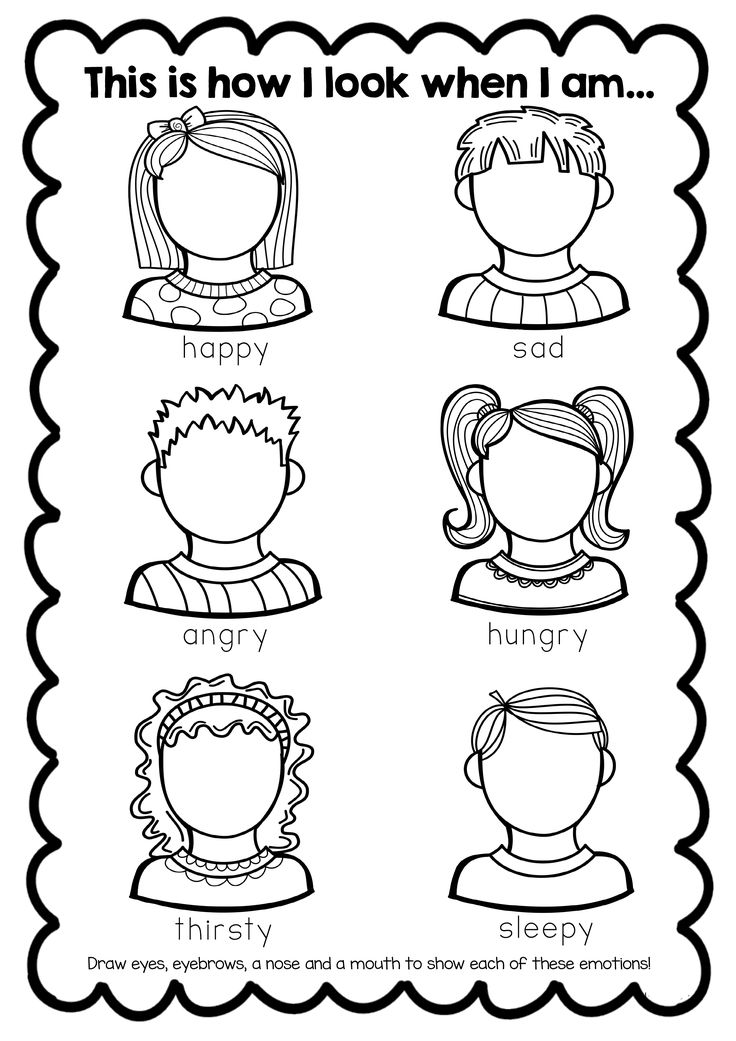 Animals’ emotions are also often clearly depicted in drawings.
Animals’ emotions are also often clearly depicted in drawings.
Cut out faces from a magazine and sort them into groups – happy faces, sad faces, angry faces, etc.
8. Emotion Songs
Music is an excellent medium for teaching skills in early childhood. These cute songs are all about emotions and kids will enjoy singing along to them.
If You’re Happy
This version of the popular song “If You’re Happy and You Know It” is by Super Simple Songs and it incorporates more emotions. Use these or make it up as you go along.
If you’re happy happy happy, clap your hands.
If you’re happy happy happy, clap your hands.
If you’re happy happy happy, clap your hands, clap your hands.
If you’re happy happy happy, clap your hands.
If you’re angry angry angry, stomp your feet.
If you’re angry angry angry, stomp your feet.
If you’re angry angry angry, stomp your feet, stomp your feet.
If you’re angry angry angry, stomp your feet.
If you’re scared scared scared, say, “Oh no!”
If you’re scared scared scared, say, “Oh no!”
If you’re scared scared scared, say, “Oh no!” say, “Oh no!”
If you’re scared scared scared, say, “Oh no!”
If you’re sleepy sleepy sleepy, take a nap.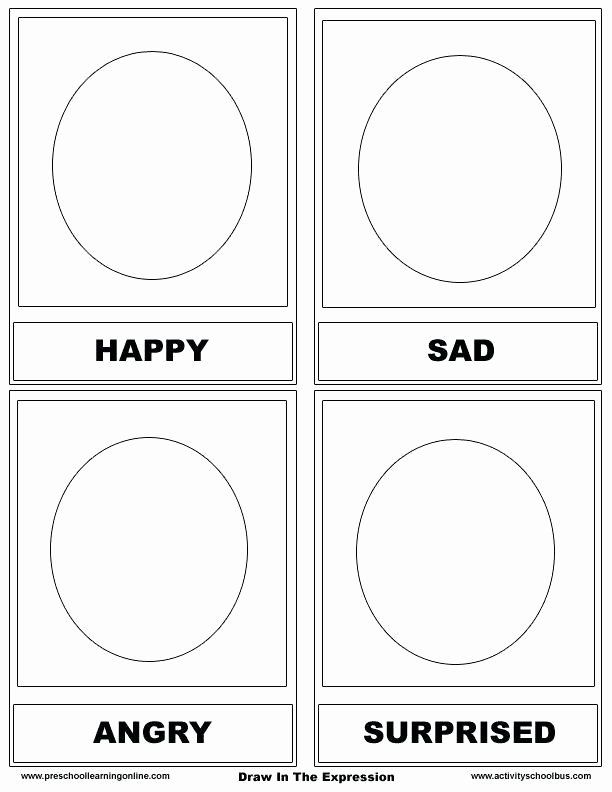
If you’re sleepy sleepy sleepy, take a nap.
If you’re sleepy sleepy sleepy, take a nap, take a nap.
If you’re sleepy sleepy sleepy, take a nap.
If you’re happy happy happy, clap your hands.
If you’re happy happy happy, clap your hands.
If you’re happy happy happy, clap your hands, clap your hands.
If you’re happy happy happy, clap your hands.
This is a Happy Face
This is a good song to introduce the topic of emotions and how our facial expression often reflects how we’re feeling.
You can listen to the tune here. Watch it and then play it in the background as you sing along and make the faces. It has great music to accompany all the emotions.
This is a happy face.
This is a happy face.
This is a happy face.
This is my happy face.
This is a sleepy face.
This is a sleepy face.
This is a sleepy face.
This is my sleepy face.
This is an angry face.
This is an angry face.
This is an angry face.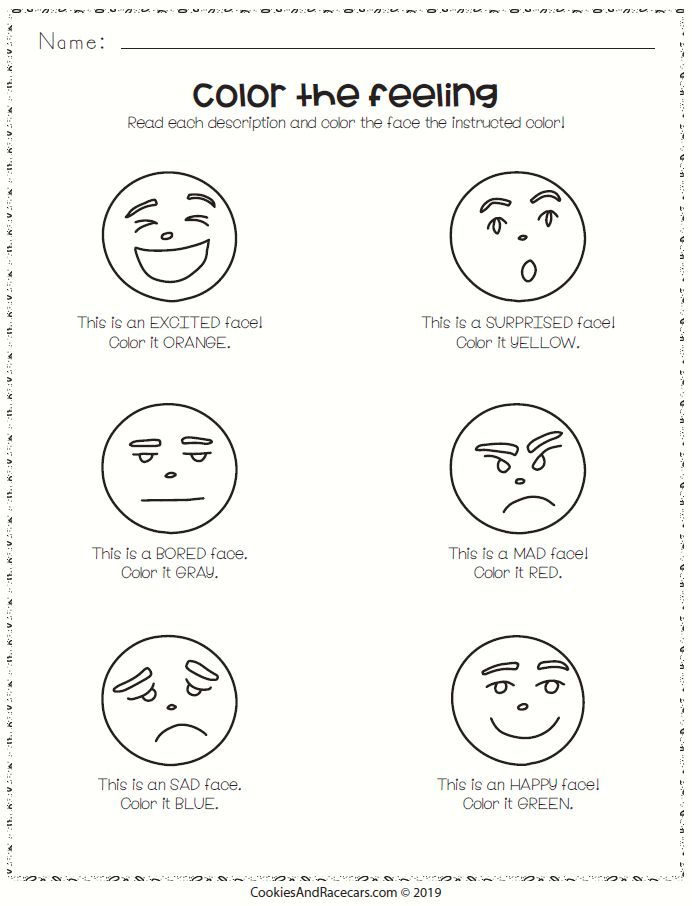
This is my angry face.
This is a surprised face.
This is a surprised face.
This is a surprised face.
This is my surprised face.
Happy. Sleepy. Angry. Surprised.
Happy. Sleepy. Angry. Surprised.
This is an excited face.
This is an excited face.
This is an excited face.
This is my excited face.
This is a sad face.
This is a sad face.
This is a sad face.
This is my sad face.
This is a nervous face.
This is a nervous face.
This is a nervous face.
This is my nervous face.
This is a silly face.
This is a silly face.
This is a silly face.
This is my silly face.
Excited. Sad. Nervous. Silly.
Excited. Sad. Nervous. Silly
“Now, let me see those faces!”
Show me your happy face.
Show me your sleepy face.
Show me your angry face.
Show me your surprised face.
Show me your excited face.
Show me your sad face.
Show me your nervous face.
Show me your silly face.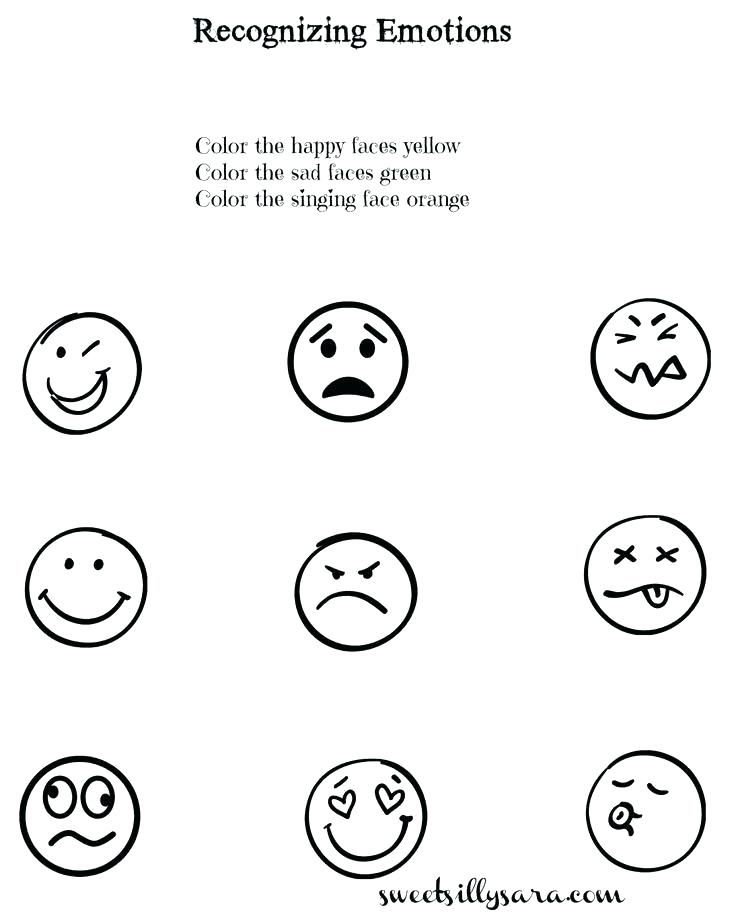
This is a happy face.
This is a happy face.
This is a happy face.
This is my happy face.
I hope you liked these simple emotions activities for preschoolers.
For more ideas, here are some social-emotional activities for preschoolers.
Get FREE access to Printable Puzzles, Stories, Activity Packs and more!
Join Empowered Parents + and you’ll receive a downloadable set of printable puzzles, games and short stories, as well as the Learning Through Play Activity Pack which includes an entire year of activities for 3 to 6-year-olds.
Access is free forever.
Signing up for a free Grow account is fast and easy and will allow you to bookmark articles to read later, on this website as well as many websites worldwide that use Grow.
- Share
Emotions and Feelings Preschool Activities, Games, and Lessons
My feelings and emotions preschool activities, games, lessons, and printables This month's theme explores two subjects close to children's health and well being: Feelings and Emotions.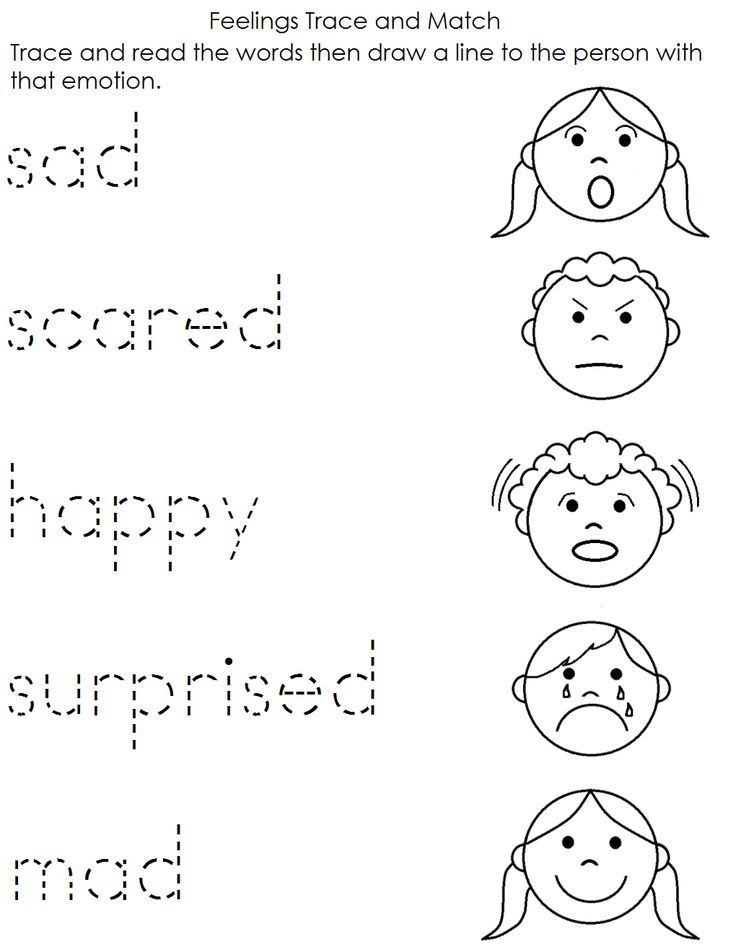 Children participate in literacy activities that help them build vocabulary and word recognition skills around topics that relate directly to their daily lives and experiences. Let your preschool and kindergarten children explore what it means to have feelings via movement, singing, drawing, writing, matching, talking, and listening.
Children participate in literacy activities that help them build vocabulary and word recognition skills around topics that relate directly to their daily lives and experiences. Let your preschool and kindergarten children explore what it means to have feelings via movement, singing, drawing, writing, matching, talking, and listening.
Themes and Projects
My Feelings
Monsters and Halloween Feelings
Crafts
Friendship Heart Painting
Funny Faces Pumpkins
Happy and Sad Face
Activities and Lessons
Emotions and Feelings Rhymes and Songs
Emotion Intro
Faces and Emotions Flip-Book
Games
Emotion Faces Matching
Making Faces Folder Game
Feelings Bingo
Movement
We're Going on a Monster Hunt
Emotions Movement Rhyme
If You're Happy and You Know It (Emotions)
Booklets and Other
Emotions Word Wall
Emotions Photo Cards
My Many Moods Emergent Reader Book
Worksheets
Emotions Write
Feelings Chart
Halloween Ghost Drawing
Free Emotions Activities, Games, and Printables
Introduce and let children explore the different feelings they can experience on any day.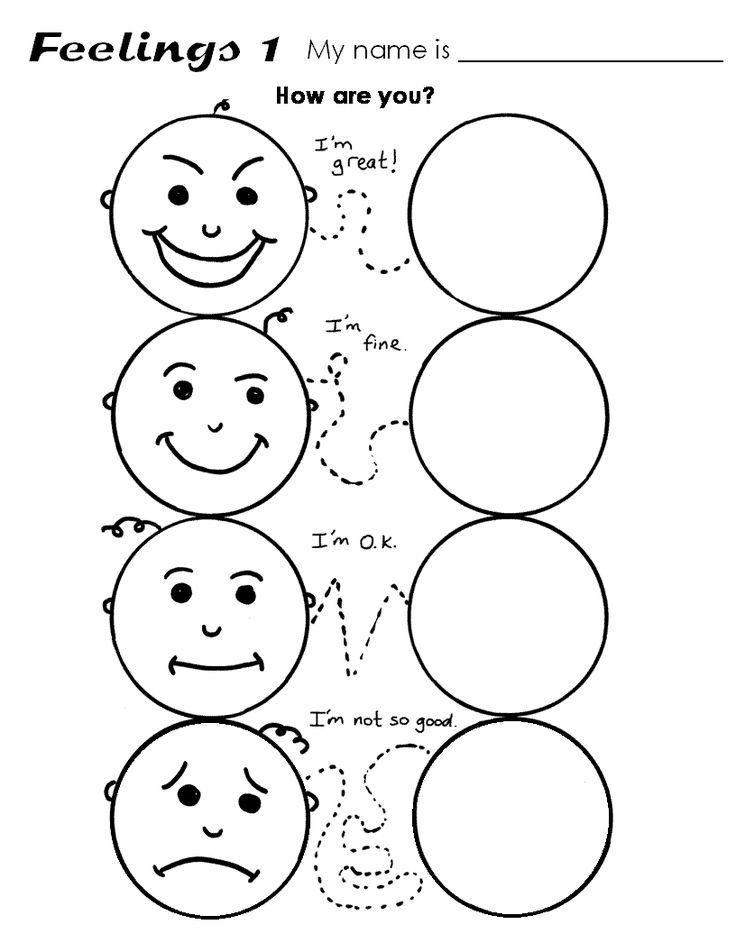 Our activities help children identify and name their emotions and feelings. Use the activities during your All About Me theme:
Our activities help children identify and name their emotions and feelings. Use the activities during your All About Me theme:
All About Me
My Feeling and Emotions
Place different size mirrors all around the room.
Fine Motor SkillsPrint out a monster face without facial features and let children use play dough to create different facial expressions and mood. Let children share with you how the monster feels.
My Feeling Preschool ActivitiesToday I feel
Read the book: Today I Feel Silly: And Other Moods That Make My Day
After reading the book prompt students to discuss a variety of feelings. Hand out a small paper plate to each child and encourage them to make a feeling puppet. Have them color or cut out and paste a feeling face on their paper plate.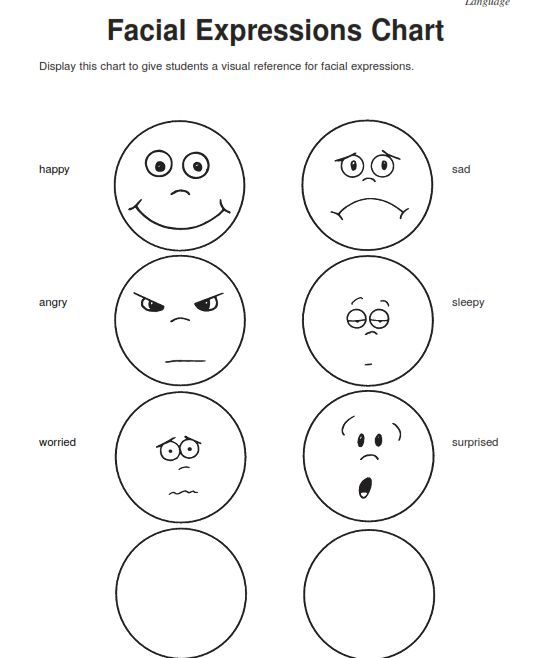 Decorate with yarn annd paper scraps for hair and ears. Attach a large craft stick to the back. Let children share their feeling puppet with the group. Re-read the book and let the children with the matching feeling hold up their puppet.
Decorate with yarn annd paper scraps for hair and ears. Attach a large craft stick to the back. Let children share their feeling puppet with the group. Re-read the book and let the children with the matching feeling hold up their puppet.
Happy and Sad
Hand out a mirror to each child. Talk about how we feel when we're happy and how it shows in our face. Sing the song "If You're Happy and You Know It." Let children look in the mirror and make a happy face.
If you're happy and you know it, show a smile.
If you're happy and you know it, show a smile.
If you're happy and you know it, and you really want to show it,
If you're happy and you know it, show a smile.
Repat by children looking in the mirror making a sad face.
If you're sad and you know it, cry BOO-HOO.
Feeling and Emotions Craft
Hand out a paper plate and a mouth piece to each child. Drill a hole to the bottom of the paper plate and attach the mouth piece with a brass fastener. Let children decorate the face. Sing the song again and let children show the matching feeling on their puppet's face.
Let children decorate the face. Sing the song again and let children show the matching feeling on their puppet's face.
Preschool Activities:
Media Root
My Feelings and Emotions Lesson and Printables (available inside our KidsSoup Resource Library)Preschool Activities:
Media Root
Sorting Out Emotions Activity
What you need:
Several magazines or magazine pages
White construction paper
Scissors
Glue
What you do:
Label several sheets of blank white construction paper with emotions words: happy, sad, mad, surprised, shy, worried, silly, proud, etc. Give children magazines or magazine pictures to look through for images of people that match each of the words. Let children cut out the pictures and glue them to the appropriate pages. The pages can be made into a classroom book once they have been filled with images.
Preschool Activities:
Media Root
Feelings Matching Game
Print two copies of the emotion cards and cut out.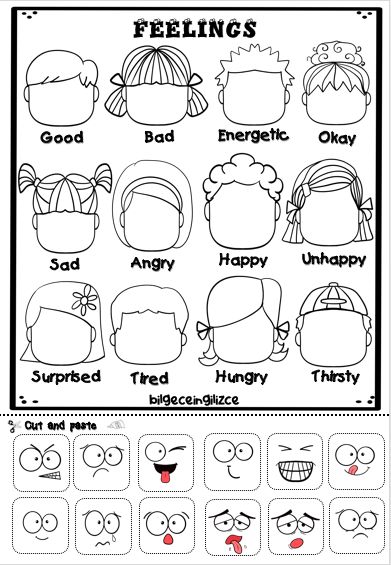 Let children match the pictures.
Let children match the pictures.
Matching Game: Place cards face down on the table. Let children turn over two cards at a time. If the cards match, they can keep them and get another turn. If the cards don't match, the next player gets a turn.
How Are You Feeling Today?
Place feelings picture cards in a row on a board. Let children pick out their name cards. Point at each emotion card on the board and name it or ask children to name the emotion. Discuss why they think the child in the picture feels that way. Ask children how they feel today. Let children place their name card below the emotion card that fits their feeling.
Sing the "I Have Feelings" song:
I Have Feelings
(Tune: Twinkle, Twinkle, Little Star)
I have feelings (point to self)
So do you (point to children)
Let's all sing about a few.
I am happy (make a big smile)
I am sad (frown)
I get scared (cross arms and make scared face)
I get mad (make fists and stomp feet)
I am proud of being me (hands on hips, shoulders straight, smile)
That's a feeling too, you see.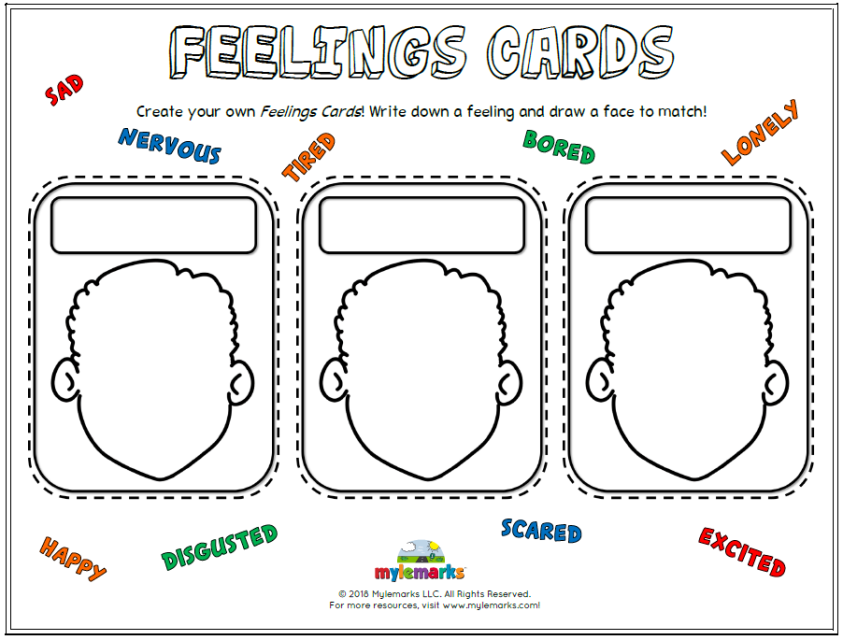
I have feelings (point to self)
You do, too (Point to children)
We just sang about a few.
Book:Guess How Much I Love You
Read the book and discuss with children how they feel when someone tells them "I love you." Sing the song:
I love You
(Tune: You Are My Sunshine)
I love you mommy
My dearest mommy
You make me happy
When I am sad
I want to tell you
I really love you!
When I'm with you, I am so glad!
Change to any other family member.
Go Away, Big Green Monster! Activities, Lessons and PrintablesBook: Go Away, Big Green Monster!
After reading the book, invite children to share with the group things that scare them (storms, snakes, etc.). Then say the following rhyme for each thing:
A Monster Goes Like This and That
By Jolanda Garcia
A monster goes like this and that (walk feet in front of you)
It's terrible (big) (use arms out at side)
BUT, I'm not scared of that! (shake head)
A storm goes like this and that (move from side to side)
It's terrible (loud) (stomp)
BUT, I'm not scared of that! (shake head)
Preschool Activities:
Media Root
If You're Happy and You Know It (Gross motor skills)
If You're Happy and You Know It
Adaptation from Original by Author Unknown
If you're happy and you know it, show a smile.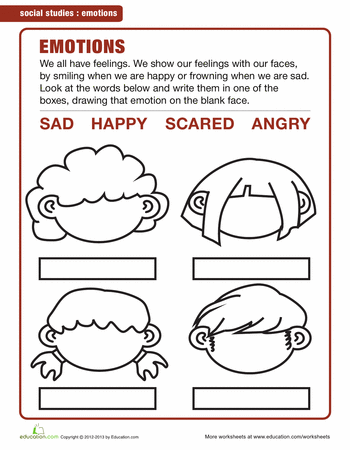
If you're happy and you know it, show a smile.
If you're happy and you know it, and you really want to show it,
If you're happy and you know it, show a smile.
Continue with additional verses for other emotions:
If you're mad and you know it, stomp your feet.
If you're surprised and you know it, say "OH MY."
If you're sad and you know it, cry BOO-HOO.
If you're silly and you know it, make a face.
If you're scared and you know it, shiver and shake.
Finish the song with: If you're happy and you know it, shout HURRAY!
|
| ||||
| Emotion Faces Cut and Color | Emotions Write and Draw |
|
|
| Creating an emotional environment for a child in preschool | |||
| Pedagogy | |||
| Author: Vladimirova Veronika | |||
| 06/24/2020 10:49 | |||
| The value of the emotional component as a basic component of human life is beyond doubt. Emotional instability, brightness, impulsiveness of manifestation of emotions are most typical for a preschool child, which is gradually replaced by greater adaptability. All this determines the main focus of pedagogical work with a preschooler - the emotional content of a child's life and assistance in understanding emotions and their regulation. Obviously, the most important factor for a child that influences his emotional state is the environment. Author : Veronika Vladimirova
|
8 months to 2 years, 2 to 4 years, 4 to 7 years
- Baby club
- How are the classes
- Educational activities for children
All types of intelligence are carefully developed in the Baby Club: social, personal, spatial, verbal, digital, spiritual, creative, sensory, physical, sensual. For each age, we choose exactly those tasks that contribute to a comprehensive and harmonious development.
Every club always has favorite general development activities, but in addition to them, many clubs offer a wide range of additional services.
Basic activities
Additional activities
From 8 months to 2.5 years
The main task of this age is socialization. Children learn to communicate with each other, find a common language, and in exciting games they learn a lot about everything in the world.
- In the classroom, kids actively develop the so-called speech center, for which the points on the palms are responsible: finger gymnastics, motor development prepare children for speech.
- The development of dexterity and coordination of movements in game tasks helps children maintain a "healthy mind in a healthy body"!
- By developing their communication skills, the guys begin to feel more confident in a new space and when communicating with new people.
- Gradually, babies learn to share, negotiate, empathize - this is how they acquire social skills that help them find friends.
- Children learn everything new in short games that alternate with no less exciting breaks.
- The guys increase their active and passive vocabulary, get acquainted with the numbers and letters that are so often found around us.
- Children are happy to try to work with various materials for creativity.
- Toddlers develop their taste in music by listening to classical music in every class.
From 2.5 to 4.5 years old
At this age, children are already actively preparing for adulthood. They strive for independence and independence, try on more and more new roles.
- In play situations, children develop their speech, do speech therapy exercises. After all, this way they will be able to talk about their great ideas and accomplishments clearly and understandably.
- They get acquainted with numbers and acquire the first counting skills, which helps them to better navigate the world around them, for example, to recognize familiar bus numbers, keep track of their toys ;) - everything is grown-up!
- They recognize the letters, get the first reading and writing skills - oh, how the child needs them to show adults that he himself knows where it says "Shop" or the name of his favorite fairy tale .
.. Any new word is very quickly associated with the image and enters into vocabulary.
- They gain knowledge about various natural phenomena and about the world: for example, about the change of seasons, about seas and continents, about the human body. That allows you to flaunt your mind and ingenuity in front of adults.
- Although it is still difficult for children at this age to perceive abstract tasks, any game in the classroom is interesting for them - visual materials, beautiful bright manuals and the skill of specialist storytellers leave no one indifferent.
- But the most important thing is that children learn conflict-free communication with their peers, they know how to defend their opinion and talk on a variety of topics.
From 4.5 to 7 years old
At this age, they are already thinking about school and preparing for it. It is important that the child is at ease there and does not experience stress in a new environment.

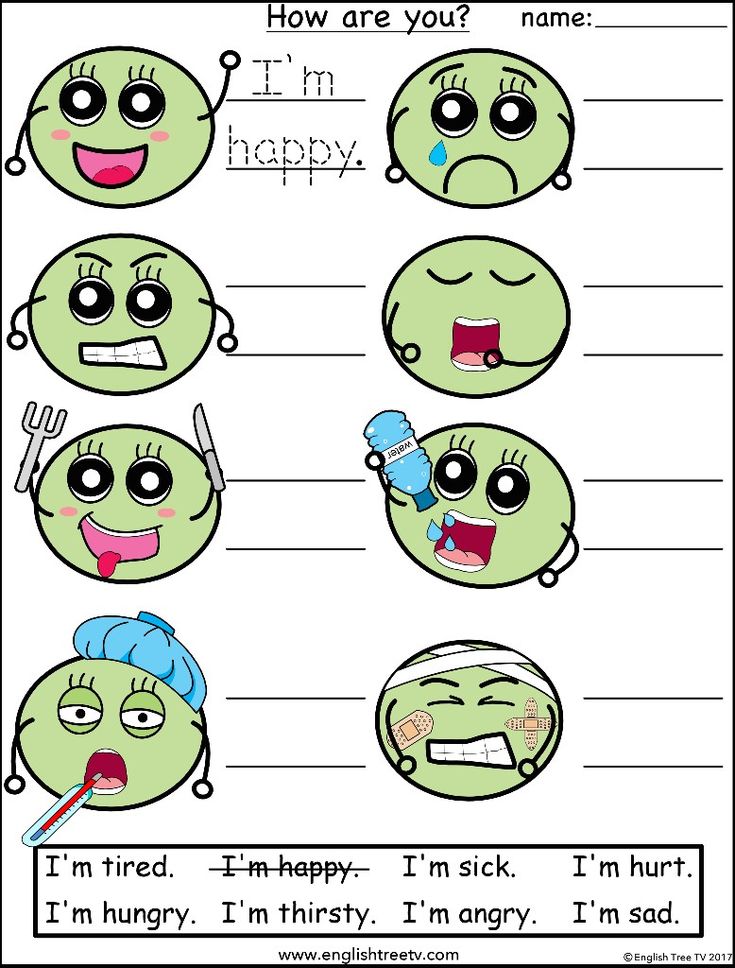 Emotions (from the Latin emovere - shake, excite) are part of the mental life of a person, which determines a person's attitude to the surrounding reality and to himself. Emotions accompany all events in life, direct the activity of all mental processes: thinking, memory, attention, speech ... That is why many psychologists (L.I. Bozhovich, V.K. Vilyunas, A.V. Zaporozhets, V.P. Zinchenko , K.E. Izard, A.N. Leontiev, B.G. Meshcheryakov, N.Ya. Semago and others) argue that the formation of a person’s emotions is the most important condition for his development as a person.
Emotions (from the Latin emovere - shake, excite) are part of the mental life of a person, which determines a person's attitude to the surrounding reality and to himself. Emotions accompany all events in life, direct the activity of all mental processes: thinking, memory, attention, speech ... That is why many psychologists (L.I. Bozhovich, V.K. Vilyunas, A.V. Zaporozhets, V.P. Zinchenko , K.E. Izard, A.N. Leontiev, B.G. Meshcheryakov, N.Ya. Semago and others) argue that the formation of a person’s emotions is the most important condition for his development as a person. 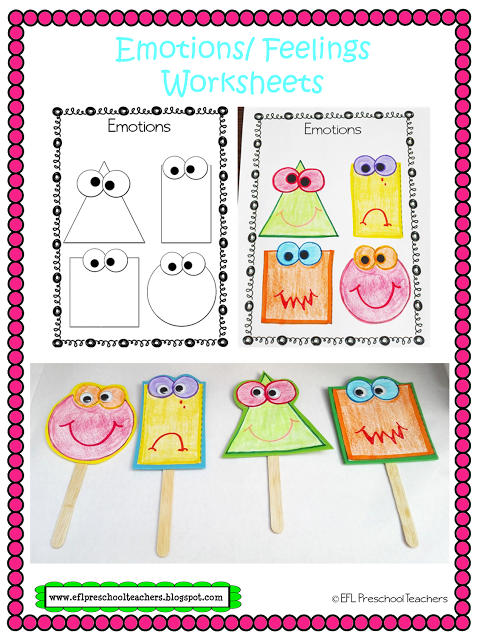 As a rule, the development environment in a preschool educational institution is understood as the organization of space and the use of equipment and other equipment for the purpose of safety, the psychological well-being of the child, and his development.
As a rule, the development environment in a preschool educational institution is understood as the organization of space and the use of equipment and other equipment for the purpose of safety, the psychological well-being of the child, and his development. 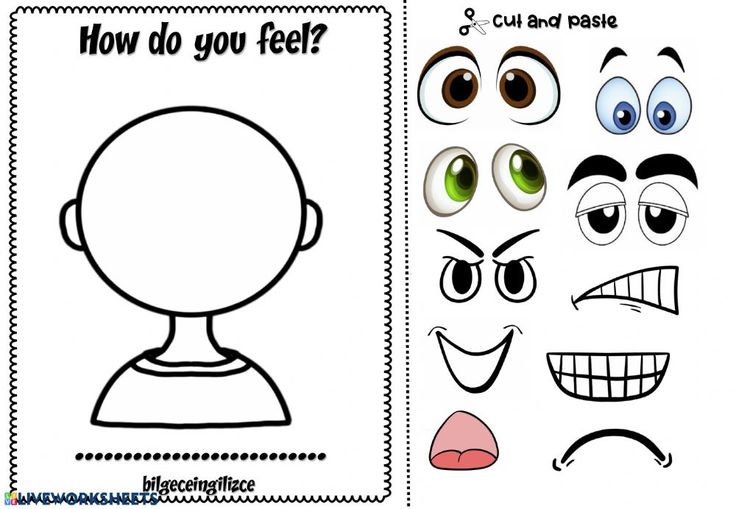 ) - an emotionally-adjusting component of the environment;
) - an emotionally-adjusting component of the environment; 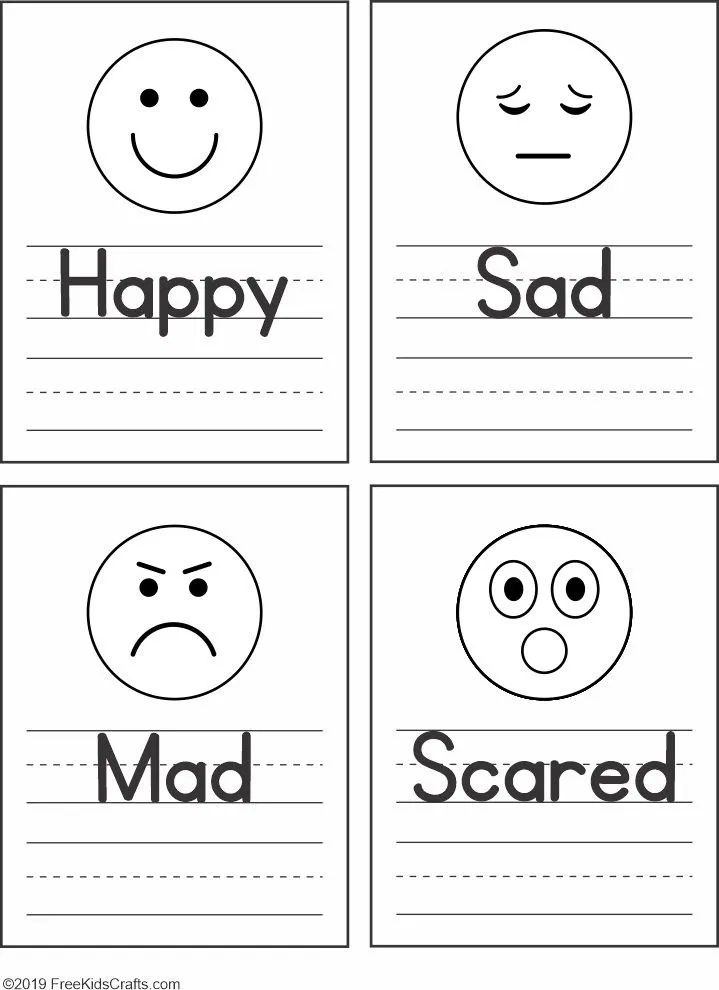
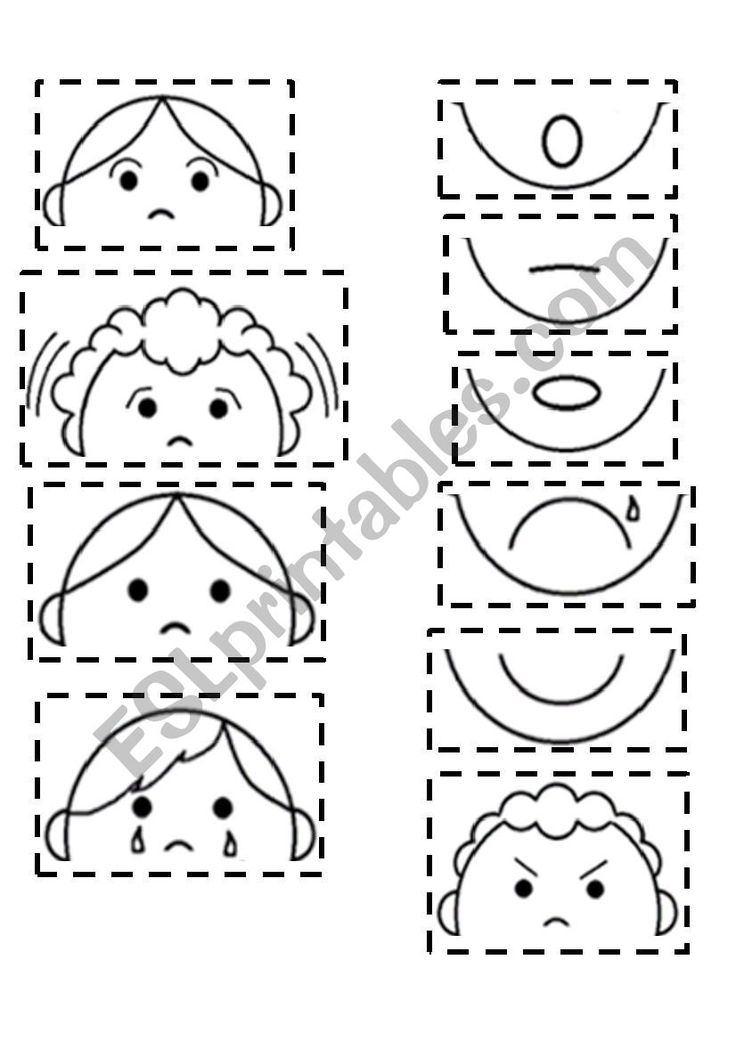
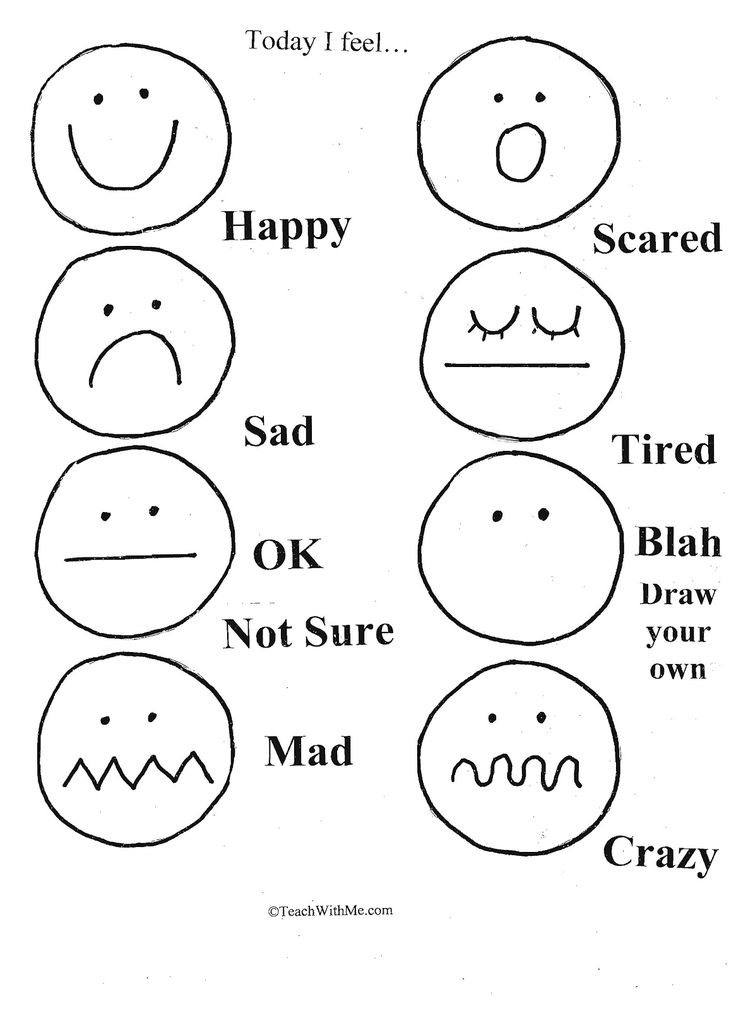 And the second is to review the existing interior and equipment in order to strengthen their emotional and developmental orientation.
And the second is to review the existing interior and equipment in order to strengthen their emotional and developmental orientation.  Maslow believed that the need for security and protection is most easily observed in young children. Preschoolers experience anxiety, turning into affects, if the environment around them changes. It is no coincidence that everyone knows the difficulties of adaptation periods in children with Њ ??????? first in preschool, then to school. A certain guarantor of meeting the need for security is for a preschool child the presence of certain regime moments.
Maslow believed that the need for security and protection is most easily observed in young children. Preschoolers experience anxiety, turning into affects, if the environment around them changes. It is no coincidence that everyone knows the difficulties of adaptation periods in children with Њ ??????? first in preschool, then to school. A certain guarantor of meeting the need for security is for a preschool child the presence of certain regime moments. 
